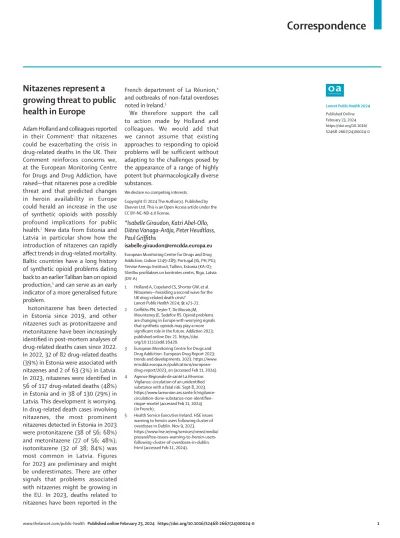Summary
This correspondence, co-authored by a number of EMCDDA staff on the subject of the growing health threat of nitazenes was published in the Lancet Public Health journal.Download as PDF
PDF files are made available as a convenience. In cases where the EMCDDA is not the originator of the document, please be aware that any PDFs available on this page may not be authoritative or there may be more recent versions available. While we make every effort to ensure that these files are definitive, before using or citing them, we recommend that you consult the publisher's website or contact the author(s) to check for more recent versions.
HTML version
Adam Holland and colleagues reported in their Comment1 that nitazenes could be exacerbating the crisis in drug-related deaths in the UK. Their Comment reinforces concerns we, at the European Monitoring Centre for Drugs and Drug Addiction, have raised—that nitazenes pose a credible threat and that predicted changes in heroin availability in Europe could herald an increase in the use of synthetic opioids with possibly profound implications for public health.2 New data from Estonia and Latvia in particular show how the introduction of nitazenes can rapidly affect trends in drug-related mortality. Baltic countries have a long history of synthetic opioid problems dating back to an earlier Taliban ban on opioid production, and can serve as an early indicator of a more generalised future problem.
Isotonitazene has been detected in Estonia since 2019, and other nitazenes such as protonitazene and metonitazene have been increasingly identified in post-mortem analyses of drug-related deaths cases since 2022. In 2022, 32 of 82 drug-related deaths (39%) in Estonia were associated with nitazenes and 2 of 63 (3%) in Latvia. In 2023, nitazenes were identified in 56 of 117 drug-related deaths (48%) in Estonia and in 38 of 130 (29%) in Latvia. This development is worrying. In drug-related death cases involving nitazenes, the most prominent nitazenes detected in Estonia in 2023 were protonitazene (38 of 56; 68%) and metonitazene (27 of 56; 48%); isotonitazene (32 of 38; 84%) was most common in Latvia. Figures for 2023 are preliminary and might be underestimates. There are other signals that problems associated with nitazenes might be growing in the EU. In 2023, deaths related to nitazenes have been reported in the French department of La Réunion,4 and outbreaks of non-fatal overdoses noted in Ireland.5
We therefore support the call to action made by Holland and colleagues. We would add that we cannot assume that existing approaches to responding to opioid problems will be sufficient without adapting to the challenges posed by the appearance of a range of highly potent but pharmacologically diverse substances.
We declare no competing interests.









